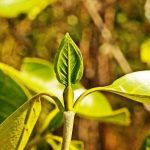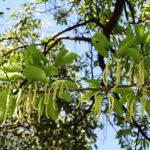TREE LIFE
August 2002
AS BEFORE PLEASE CONFIRM WITH ANY OF THE COMMITTEE MEMBERS THAT THE SCHEDULED OUTINGS AND WALKS WILL ACTUALLY TAKE PLACE. SEE THE BACK PAGE FOR PHONE NUMBERS.
MASHONALAND CALENDAR
Saturday 3rd August Botanic Garden Walk. Meet in the car park of the Botanic Garden at 10.45 for 11 am. Tom is away on an overseas holiday so this will be an informal walk around the gardens looking at whatever takes our fancy. Come along and enjoy a fun walk.
Sunday 18 August.Pax Park which is the Girl Guides camp in the Chivero (Lake Mac.) National Park is this month’s venue. Interesting lakeside woodland, rock art and a peaceful spot is the carrot. There is a National Park’s entry fee of $30 per person payable at the entrance gate and a $50 per person charge for Pax Park, which will be collected at Pax Park.
Come prepared for an all day outing with lunch and a chair and meet at 9.30
Saturday 24th August. Mark’s next walk will be to the Game area of the Mukuvisi Woodlands. Meet in the car park at 2.30pm. with your $100 entrance fee.
Saturday 7th September. Bot. Garden walk.
Thursday 26th to 29th September. A self catering trip to the Eastern Highlands and Aberfoyle Tea Estates in the Honde Valley is being planned, with Tom Muller as our guest.
Accommodation is in little wooden rooms on the lawn of the club ($500 per person per night), or camping on the lawn with own tents ($300 per person per night). All club facilities – showers, toilets, fridge, braai and wood will be at our disposal, as well as the swimming pool and TV lounge.
Please phone Maureen Silva-Jones to make your reservation. Nick and Sue Fawcett with Tom have selected the best forest patches in the area to explore.
MATABELELAND CALENDAR
Sunday 18th August Matobo Conservation Society visits the Mtsheleli Dam and Khumalo Communal Lands with Mr. Ngoni Chiweshi, a National Parks ornithologist, and will be looking at many things of interest including black eagles.Meet at 8.15am at the Churchill Arms. The National parks entrance fee is $50 per person. For more information please phone Jonathan.
JOHN and LILIAN COTTRILL
We bid farewell to John and Lilian Cottrill who are emigrating to live in England. John has been a regular attender at meetings in his area and the Society enjoyed several visits to Guitingwood near Bindura to see his fish and waterlilies and to explore the interesting flora on the kopje – John’s private arboretum. The most recent occasion was 18th March 2001, when we had a wonderful if slightly damp day there shortly before his 80th birthday. John was also a trustee of the Society. He will be long-remembered. We wish him and Lilian well in their new lives in the UK.
BOTANIC GARDEN WALK: 1 JUNE 2002
We made slightly more than double figures for this walk to have a look at members of the Family Leguminosae, subfamily Papilionoideae. Tom told us that this is a clear-cut group, with pea-like flowers of 5 petals, each with 10 stamens, 1 of which hangs down free. The fruits of some species, eg the South American Tipuana tipu(tipu tree), are winged samaras, while others, eg the indigenous Cordyla africana (wild mango) have fleshy fruits, resembling drupes. There are no species with bi-pinnate leaves in this subfamily, unlike the situation in the other two subfamilies of Leguminosae, ie Mimosoideae and Caesalpinioideae, but some species in Papilionoideae do have apparently simple leaves, eg Philenoptera nelsii (apple-leaf).
In relatively recent years botanists have tended to move away from family names such as Leguminosae and Papilionoideae, and to replace them with names based on representative genera. The new name selected for Leguminosae-Papilionoideae is Fabaceae, based on the genus Faba-but here we have a problem, for some authorities, eg DJ Mabberley, The Plant-Book, have sunk the genus Faba under Vicia, thus destroying the raison d’être for the family name Fabaceae. Perhaps someone knowledgeable could clarify this particular question for us. In the meantime, my own preference is to stick with Leguminosae-Papilionoideae.
Our first species was Dalbergia melanoxylon (African blackwood; zebrawood). This tree is widespread in Zimbabwe (perhaps absent from the Eastern Highlands alone), and reaches its biggest sizes in the southeast of the country. This is a spiny tree with leaves clustered on short, hard shoots. It has attractive white flowers, and the bark of the stem flakes off in squares or strips. It is generally a multi-stemmed tree, and has a very hard, close-grained, purplish-black or reddish-black wood that is highly suitable for musical instruments. There is good reason to suggest that this wood was the ebony of the bible (Ezekiel 27:15), but that would be too much of a digression from the purpose of this write-up!
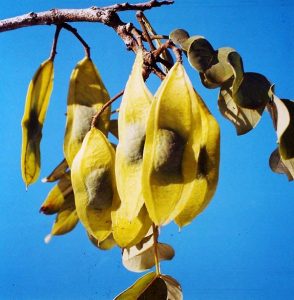
Xeroderris stuhlmannii. Photo: Bart Wursten. Source: Flora of Zimbabwe
Next, we saw Xeroderris stuhlmannii (wingpod), which, like mukwa, has a blood-red sap. It is a species of the hot, dry areas, and is virtually absent from the central-watershed region. It may be found in the jesse-bush of the Zambezi Valley, and in all sorts of soils and site conditions. The flowers are white and butterfly-shaped, and the fruit is a distinctive, longish, flattened pod with a hard membranous wing around the edges. This species has a fairly good utility timber that is slightly heavier than mukwa.
Pterocarpus lucens ssp antunesii (small-leaved bloodwood) was the subject of our next stop. This used to be known as P. antunesii, and is a species of the Zambezi Valley and the extreme southeast of Zimbabwe. It may be a fair-sized tree or no more than a shrub, and is generally multi-stemmed. Large specimens may be seen around Mana Pools. The bark is smooth and pale grey. The pea-shaped, pale yellow flowers are very showy, but the flowering period is usually short-lived. The wood is half again as heavy as that of the related mukwa, but it does not have the colour or the figure of mukwa-it is a uniform, yellowish colour, with no differentiation between sapwood and heartwood.
One of the great trees of the Zambezi Valley and the southeast lowveld is Cordyla africana (wild mango), which we saw next. This is essentially a tree of the lowveld riverine forests, and may reach very large sizes (I have found specimens with bole diameters in excess of 2 metres, heights up to 32 metres, and one particularly fine tree had a crown spread of nearly 60 metres). The species has very showy flowers and, as mentioned in the introduction, a fleshy fruit the size of a small mango, hence the English common name. The fruit is edible-but only if you are desperately hungry! The species has a somewhat heavy and coarse-grained, dark-brown heartwood, which can be made into quite attractive furniture. Some authorities place Cordyla africana in the subfamily Caesalpinioideae, so it is seemingly a sOrmocarpum zambesianum pecies that is regarded as a bridge between the two subfamilies.
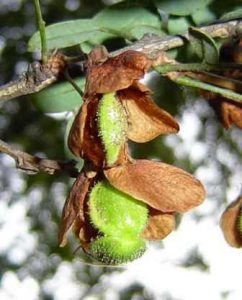
Ormocarpum zambesianum. Bart Wursten. Source: Flora of Zimbabwe
On, next, to something quite different from what we had been examining-the shrubby Ormocarpum zambesianum(Zambezi caterpillarpod). The plant had numerous, persistent, old flowers (a characteristic of the genus), and pods that were not as hairy or as caterpillary as we saw later in O. kirkii.
Erythrina livingstoniana (aloe erythrina, or aloe coral-tree) has a bole covered in heavy, bossed, thorns, and produces large, scarlet, aloe-like flower heads, hence the English common names. This is the most tropical of our species of Erythrina, and is confined to the Zambezi and southeastern lowveld areas. The specimens in the Botanic Garden have flowered only in recent years, and we saw the pods from the most recent flowering. All four species of Erythrinain Zimbabwe have distinct seed sizes, those of E. livingstoniana being the largest. It would be worth keeping an eye on the specimens in the Botanic Garden to try to catch their very striking flowers (in January-February, according to the boffins).
Next, we had a look at Xanthocercis zambesiaca (nyalaberry, or nyala tree), one of the striking species in the Zambezi and Save-Runde lowveld areas, where they are generally seen as large, multistemmed trees. It has noticeably smaller leaves than Cordyla africana, but the two species are often confused. The fruit of this species is also a fleshy, edible berry, smaller than that of Cordyla, but somewhat more palatable. The wood is extremely heavy, hard, tough, and difficult to work, which is why the species is generally left untouched. The specimens in the Botanic Garden have grown very slowl
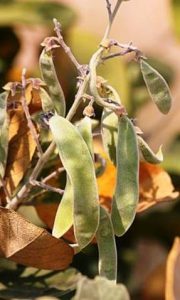
Philenoptera nelsii. Source: Flora of Zimbabwe
.The name Philenoptera violaceafor our next species came as something of a shock for those of our party who had always known it as Lonchocarpus capassa, the rain tree. But the name has been changed, and we will just have to get used to the new nomenclature. According to DJ Mabberley (The Plant-Book) the genus Lonchocarpus is confined to tropical America, while Philenoptera is found in both tropical Africa and tropical America. The rain tree is widespread in Zimbabwe, but its habitat is often riverine, and it occurs commonly on sandy soils. It has large, pinnate leaves, with leaflets of different sizes, the terminal leaflet being the largest. It is numbered among a relatively small number of our indigenous tree species that have blue flowers, and its common English name comes from the “rain” that is produced by large numbers of frog-hoppers that suck sap out of the tree and eject almost pure water, often making the ground thoroughly wet under the tree. The wood is on the heavy side, but it is said to bend well and to have properties that would make it suitable for such items as hockey sticks.
Our next stop was at Pterocarpus rotundifolius ssp polyanthus (round-leaved bloodwood). This particular subspecies has a larger number of leaflets than the more common subspecies rotundifolius, and the leaflets are also smaller. It is a particularly showy tree in flower (deep yellow), but it is seen in the wild only in the Zambezi Valley.
We then looked at Ormocarpum kirkii (small caterpillar-pod), a shrub very similar to O. zambesianum, but with larger leaves and short leaf spurs that, themselves, look like caterpillars. This species also had persistent, old flowers, and inside were small, curled, (caterpillar) pods. This species has a fairly heavy, grey-brown heartwood of good working properties, but the small sizes limit its uses to trinket boxes, turnery, etc.
Erythrina abyssinica, our well-known lucky-bean tree, or red-hot-poker tree, was next on the list. It was coming into flower at the time of our visit, and Tom noted that it was flowering a little earlier this year. He also mentioned that this species has the second smallest seeds among our species of Erythrina the smallest being those of E. lysistemon (coral tree). In the long-ago days of wagon transport the wood of E. abyssinica was often used for brake blocks; its light weight and relative softness made it ideal for the purpose.
Then followed a short digression while we had a look at a specimen of Alluaudia (family Didiereaceae), a xerophytic plant from Madagascar. The stem of this plant was covered in spirals of leaves, which concealed some horrendous thorns, and we were given to understand that it had been planted not only as a botanical curiosity, but as a weapon for use against Tom’s mortal enemies!
On, then, to see Dalbergia martinii (Zambezi dalbergia), a jesse-bush species with fairly large, soft leaves, and very sticky, single-seeded pods. This is confined to the Zambezi Valley, and usually occurs as a shrub or climber-only occasionally as a tree up to about 4 metres tall.
Next was Pterocarpus brenanii (large-leaved bloodwood), a shrub or small tree from the Zambezi Valley and the southeastern lowveld. Distinguishing features of this species are its large leaflets (the basal pair being the largest and the terminal leaflet the smallest) and the large and persistent stipules at the base of the petiole. The pod is smooth and is surrounded by a hard wing. The wood of this species has much the same weight and other properties as that of P. lucens.

Philenoptera nelsii. Source: Flora of Zimbabwe
Our final species was Philenoptera nelsii (formerly Lonchocarpus nelsii)-apple-leaf or apple-leaf lancepod-a species of the Kalahari-sand region of northwest Matabeleland. All the leaves we saw were apparently simple, an unusual feature in leguminous plants. According to the experts, however, the leaves are, in fact compound, but are often reduced to a single leaflet in drier areas. Under more favourable conditions there are usually one or two pairs of leaflets, plus a terminal leaflet. The wood of this species is very similar in all respects to that of P. violacea, but it is finer textured.
So, we covered 15 species all told, in what was a most absorbing morning, and it was good to see so many new faces among those who were present. Our sincere thanks to Tom for the insights into a very interesting group of trees and shrubs, and we will continue with the Papilionoideae at next month’s Botanic Garden walk.
(Notes on the wood properties of the species included in these notes were taken largely from B Goldsmith & DT Carter, 1981, The Indigenous Timbers of Zimbabwe, published by the Forestry Commission as Bulletin No 9 in the series The Zimbabwe Bulletin of Forestry Research.)
Lyn Mullin
MUFUTI 16th June 2002
June’s Sunday outing was held on the smallholding of Gary and Liz Dudley on Cromlett Road, in the hills on the South side of the Enterprise Valley. The name of the property reflects the large, spreading Brachystegia boehmii that grow in front of the house. Large numbers of smaller trees of this very attractive species were present in the miombo woodland that covers the hills in that area, evidence of a significant drop in altitude from Harare.
Sixteen members met in the beautifully laid out stable yard at the foot of the hillside for tea and muffins before the walk. There we had the first of the sweepstakes organised to raise funds for the Society, which was won by Anne Hatley. After tea we climbed up the drive, ambled through the garden to the back of the house, and botanised under the guidance of Mark on the hillside. We had a welcome cool drink at the Dudleys’ rustic guest cottage and our picnic lunch back in the stable yard, before climbing the hill once again to see what we had missed and to admire the views over the Arcturus Valley and North to the hills of Chinamora.
The predominant species on the hillside were Brachystegia spiciformis, B.boehmii and Julbernardia globiflora. The Dudleys were rather concerned that several small groups of mature J.globiflora had died and wondered what the reason might be; one suggestion was a fungal infection. There was also a surprising number of other trees growing in the woodland, and some interesting species that had been planted in the garden.
I was particularly interested in the fine feathery leaved species, the Acacias and their look-alikes, which I feel should be easy to recognise, but often are not. The first of these that we met, in the garden, was Faidherbia albida, the pods of which are such a favourite of elephant at Mana Pools. It shouldn’t have been there, as it is a lowveld species, and it had us puzzled for a minute, but its white, zigzag branchlets gave it away. It was putting out new green leaves, in mid-winter, hence one of its common names, Winter Thorn. Acacia amethythophylla was common, as it often is in miombo woodland. Its main feature is the size of its leaves, with a long rachis and long pinnae widely separated, much like a Jacaranda on superficial inspection. Its spines are straight, often inconspicuous and sometimes flattened laterally, like the point of a knife. Also within the woodland were a number of very small specimens of Acacia goetzii, which has hooked thorns. It really had us baffled, because there were minute hooks on the underside of the leaf rachis as well, and we didn’t think goetzii had those, but according to the books it does, so that confirmed the identification. The trees looked very different from the A.goetzii that one can buy from the nurseries in town. Those have much larger, rounder leaflets and may represent another subspecies, although the taxonomy of the species is very unclear because it is so variable.
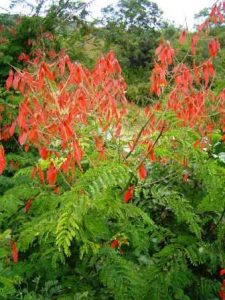
Pterolobium stellatum. Photo: Bart Wursten. Source: Flora of Zimbabwe
There were a few tangles of Pterolobium stellatum in the undergrowth, a creeping shrub which we don’t often notice because it is rather inconspicuous until it flowers and fruits, or one gets caught up in it. Its trademark is the presence of single spines on the upper surface of the leaf rachis as well as paired hooks on the lower surface. It is probably as good a deterrent to intruders as Caesalpinia decapetalata, Mauritius Thorn, which was planted as a security screen outside the fence around the house. This species has wider leaflets than the creeping, climbing Acacias, so cannot be confused with them. It also has upright, showy, yellow flower heads. It was introduced to Africa from Asia and is an aggressive invader; the Dudleys keep it under control by pruning twice a year, so that it never seeds, but I did find one plant that had escaped into the adjoining woodland.
The last of the thorny species of this type that we encountered was Dichrostachys cinerea, which is easily recognised by its unpaired, spiny branchlets. Species without thorns seen were Peltophorum africanum, easily recognisable if its threadlike, branching stipules are present, Albizia amara, which is superficially very like an Acaciabut has no thorns, and the ubiquitous, iniquitous Jacaranda mimosifolia. Small specimens of the last-named can be identified by their pointed leaflets and the presence of a terminal leaflet at the end of each pinna.
It is always a surprise to find trees in flower in the middle of winter in the African bush. Senna singueana, the misnamed Winter Cassia, provides splashes of bright yellow on the roadsides at this time of year. Faurea rochetiana (formerly F.speciosa) were numerous on the hillside, most bearing long, hanging flower heads that seemed to consist of a core of cotton wool, from which pink petals radiated. Turraea nilotica was just coming into bloom, with white flowers consisting of a central tubule surrounded by petals that curled backwards. The composite flower heads of Vernonia colorata were also just opening. This species has glandular but non-hairy seeds, which is the only way it can be distinguished easily from Vernonia amygdalina, the seeds of which are hairy. We had to look very closely to see the white flowers of Gymnosporia senegalensis, formerly Maytenus senegalensis, but they were there, in clusters at the bases of the groups of leaves. The most spectacular of the flowering plants was Podranaea brycei, the Zimbabwe Creeper, which does not occur naturally in the area but was planted in the garden. It was in full bloom, with large, pink, tubular flowers and long, curved, cylindrical pods containing winged seeds.
Our walk included a detour into the orchard to look at some of the tropical fruit trees that escape into the forests of the Eastern Highlands and may cause problems with identification. Mango trees have rather featureless, strap-like, glossy leaves but give themselves away by a strong scent of mango when the leaves are crushed. Not so avocados, which have similar leaves but no distinguishing features unless they are in fruit. Macadamia nut trees, on the other hand, have very distinctive leaves, arranged in whorls of four, with very serrated margins. While some of us studied these trees, the others helped themselves to naartjies from the rest of the orchard.
We are grateful to the Dudleys for making us so welcome and for allowing us to spend such an enjoyable and informative day in the country. Liz even tore herself away from the Ireland match at the World Cup in the afternoon to make sure we were happy. Mark as always showed endless patience in trying to teach us how to recognise the plants that we came across.
-J.A.Lawrence
The Final Chapters of BAOBABS IN MY SOUP By Lyn Mullin.
THE HMS MERMAID TREE
The only story of a noteworthy Australian boab that has come to hand concerns Lieutenant Phillip Parker-King, who was the first Englishman to describe the trees. He carved his cutter’s name on a “gouty-stem tree” in 1820 at Careening Cove, near the mouth of the Prince Regent River. The legend, “HMS MERMAID 1820”, carved on a twin-stemmed tree, is still clearly legible today.
However, there has been fairly extensive documentation of the significance of the boab in the cultural life of the Aborigines. The trunks of the trees at their camping sites were frequently elaborately carved with devil-rays, crocodiles, snakes, turtles, etc, and often pigment was packed into the carved areas, rapidly turning a rather drab camp into an art gallery. Many of the figures carved on boabs were of mythological significance, being creatures said to have passed through the region during the ‘dream-time’. In this mythical time a giant snake and the moon are said to have rested at a place called Karunjie, and today there are carvings of giant snakes on several boabs. This is not so surprising, because in Aboriginal mythology the serpent is associated with water, rain, and the rainbow, and is one of the most common motifs in Aboriginal legends. The boab not only stores water that can be tapped for use, but it conspicuously bursts into life with the onset of the rains. Because of the water and food it provided, and the domestic and ceremonial activities conducted in its shade, the boab has its roots deep in the psyche of the traditional Kimberley Aboriginal.
MADAGASCAN BAOBABS
No specific stories have come to hand from Madagascar, but the baobabs in that country are spectacular and distinctive trees, and they are known to have considerable cultural significance. The lack of documented folklore probably reflects insufficient ethnobotanical work rather than any paucity of folklore in Madagascar. However, many individual baobabs in the southwest of the island are known to be sacred, supposedly being occupied by spirits. These trees can be recognized by the offerings left at their bases – rum and incense for good luck or fertility; coins for wealth; and food items (rice, maize, sweet potato, plantain) for a good harvest. The rum is often placed in the empty shells of the giant land snail, and these shells can even be found neatly arranged at the base of a tree that has not recently been used as an offering site. All the sacred trees that have been recorded by one observer were A. grandidieri and A. za, each species playing a cultural role for a different tribe.
Acknowledgements
Rowan Cashel – The Baobab in Fact & Fable.
David A Baum – The Baobabs of Madagascar.
David A Baum – The Comparative Pollination and Floral Biology of Baobabs.
DJ Boland et al .– Forest Trees of Australia.
P Armstrong – The Disjunct Distribution of the Genus Adansonia.
GE Wickens – The Baobab-Africa’s upside down tree
JD Skinner & RHN Smithers – The Mammals of the Southern African Subregion
Lyn Mullin
MORE ON BAOBABS.
Lyn Mullin’s account of baobabs brought to my mind some memories and questions on this interesting tree. I so well remember the huge copper coloured models of the tree featured at the Rhodes Centenary Celebrations in Bulawayo in 1953.
My wife and I once visited the very large specimen on Devuli. This was located near the Turgwe pump station which had supplied water to the distant Umkondo Mine many years before. This tree, although large in stem diameter, appeared out of proportion in that the upper branches were smaller than might be expected on such a large trunk, so much so that I suspected it might have been two baobabs growing so close together that the stems had fused.
Baobabs thrive in the hot arid areas of Zimbabwe. Large specimens are put at between 1 000 and 3 000 years old which makes it more than surprising that in the relatively short 100 odd years that we have known these trees, so many specimens have met their demise from drought directly or indirectly. In the droughts of the 1970’s many fine specimens died in the Bubye / Beit Bridge area collapsing into heaps of straw coloured pulp which took some years to decompose away. This phenomenon showed the extent of the root system of these trees as the roots also perished leaving collapsed channels on the ground surface which extended 30 paces or more from the trunk. The soils were very shallow in that area which would accentuate the effects of any shortage of rain but it was nonetheless surprising to me in retrospect that those trees, which had thrived in that climate as variable as it is for more than a thousand years, should be killed suddenly in our time. Surely in that time span there had been worse droughts? Ecologists at the time pointed to overgrazing by cattle as enhancing runoff of the little rain that fell and it was this that tipped the scales. One is left wondering if there were in fact some other factors involved.
During the droughts of the 1980’s many fine specimens of baobabs were destroyed in Gona re Zhou, not directly as a result of drought, but due to the attention of elephant which took to eating the stem tissue which they gouged out with their tusks. Peter Taylor has already referred to this phenomenon in his note. This was the result of some gross overstocking by elephant and again must be seen as very unusual given the age of these trees which had thrived there for between 1 000 and 3 000 years.
As a student on vacation in 1949 I was tripping through the middle reaches of the Zambesi when I met Major Trollip who was the local Magistrate at Katimu Mulilo. A rotund man with a large corporation, he was a well known character the more so because he had built himself a flush toilet in a cavity of a baobab near his abode which I personally had the priveledge of using. I saw this tree again some 46 years later with the toilet intact, but no longer in use, although now surrounded by building development in this remote spot.
Then there was the fine baobab on the left bank of the Lundi which Thomas (Murray ) McDougall of Triangle fame and Brigadier ‘Scrubs’ Hartshorn used each year as a hunting camp. They built a shower in the cavity of this tree. Sadly, the tree died years ago as a result of irrigation of nearby citrus groves. Interestingly, many baobabs were left standing in the newly cleared irrigated sugar fields of the lowveld as they were too difficult to remove mechanically. However, most did not survive very long. The annual cane harvest fires and the water logging of the shallow soils due to irrigation, killed them.
It is revealing in this series of stories on baobabs how often individual trees have been associated with particular persons giving a historical significance to the tree, let alone its wide biological interest. This is mostly due to the prevalence of sizeable and accessible cavities in the stem which offered protection from the elements to the traveller. A good example is the baobab on the hillside overlooking the RIFA camp near Chirundu where a small aperture leads to a sizeable cavity inside.
Of biological interest is the fact that bees often find favourable hive sites in baobabs – the tell tale pegs knocked into the stem serving as a ladder for honey collectors giving the story away. There was also the widespread habit of chopping out large squares of outer bark from the tree which, after retting and beating, served as a crude fabric for early inhabitants. The scars heal and can be seen for years afterwards. Baobabs are preferred nesting sites for raptors, vultures and Maribou Storks as well as for the gregarious Buffalo Weavers, another reason for making them favourites!
-JHWilson
BAOBAB SNIPPETS
FROM DICK PETHERAM’s FILES
In an article that appeared in Wild Rhodesia No 5, November 1974,Colin Saunders wrote of the large baobab at Fishan’s crossing on the Runde River, where the famous Cecil (Bvekenya) Barnard used to camp. In the crevices of the tree a large number of European swallows sought refuge in the devastating cold spell of November 1968-and died, as so many other wild creatures did in the lowveld at that time.
In the same volume of Wild Rhodesia Colin Saunders wrote of one famous water-reservoir baobab known as “Banira makapiri” in the waterless waste between the Bubi and Mwenezi rivers, which “offered a life-saving facility to many Shangaans trekking down our southeastern border”. An outstanding water-reservoir baobab was reported from the Ngarwe Communal Lands by H Nicolle, formerly Secretary for Internal Affairs.
The Nyamuswa spiritual tree on the border of the Umfuli Communal Land is a baobab where, according to SH Fynes-Clinton, the people of Nemakonde gathered to propitiate the tribal spirit.
There was a baobab in Chief Mola’s area on the Zambezi that was believed to host the spirits of dead chiefs. With the building of Kariba, and the removal of the people from the land that would be flooded, the spirits were enticed to move to a new site in the barrel of a musket.
According to Plewman De Kok, writing in “Bundu Briefs” in 1958, many of our baobabs were in danger of being destroyed in the 1930s when some South African businessmen floated a company to cut the trees for pulping for paper. This raised a general outcry here, in South Africa, and in Mozambique.
A small group of three baobabs in the Kyle National Park is thought to have been planted by Basutos who had been brought up by Rhodes as cattle handlers at the end of the 19th century.
A baobab is used as an international boundary beacon, known as Baobab Beacon, at the extreme northeast corner of Zimbabwe, where the Mazowe River leaves the country.
“METEORIC GROWTH” OF TREES IN SIBERIA
In 1908 a large meteorite landed in the Tunguska Forest region of Siberia, blowing pine trees flat for miles around the point of impact. It has now been reported that, after the catastrophe, regrowth of trees in this area was seven or eight times faster than normal. One of the theories trying to explain such an extraordinary growth suggests that the meteor exploded before it reached the earth and that the resulting blast was of a thermo-nuclear nature generating some strong radiation which could stimulate growth.
(The Star, Nov. 28, 1960)
STEPHEN MAVI
We recently learned with sadness of the death of Stephen Mavi. Stephen was a co-author of the second edition of the Rhodesian Botanical Dictionary (1972), a work which remains very useful today. He was well known as an authority on the uses of the indigenous flora and was a friend of the Society in various ways.
ROOTNOTE
From Alistair Hull
According to Webster’s Dictionary, true Myrrh is obtained from a tree, Commiphora abyssinica of East Africa and Arabia. The Myrrh of the Bible is supposed to have been a mixture of Myrrh (Commiphora abyssinica) and Ladanum, (Cistus incanus). I always thought it to be just C. abyssinica.
The whole of this issue of Tree Life has been sponsored by the actuarial company
Pentact (Pvt) Ltd
MARK HYDE CHAIRMAN


